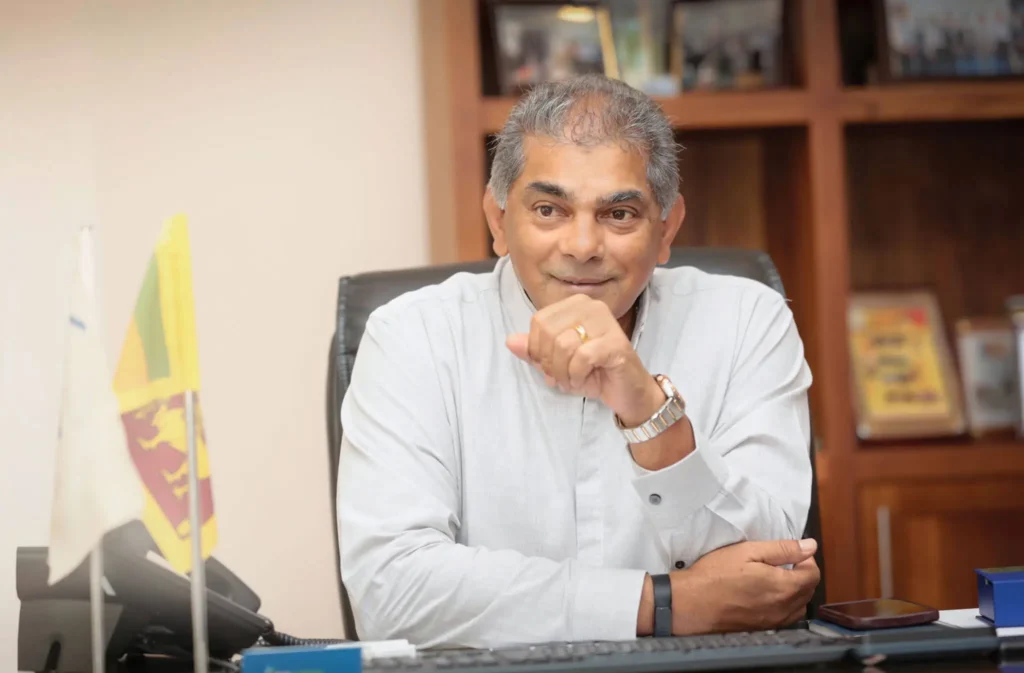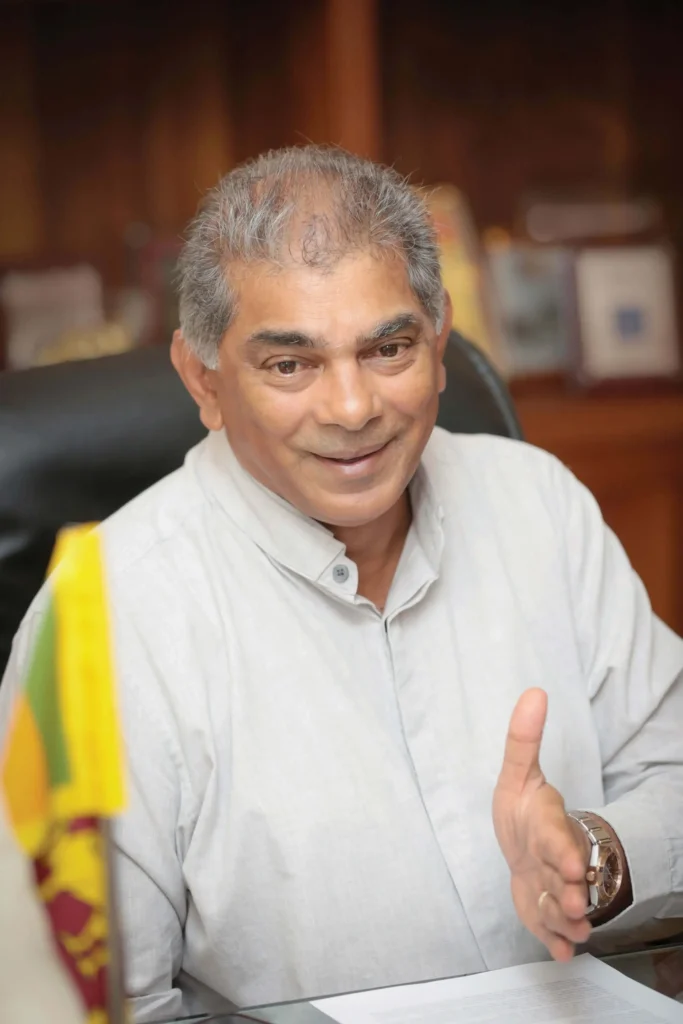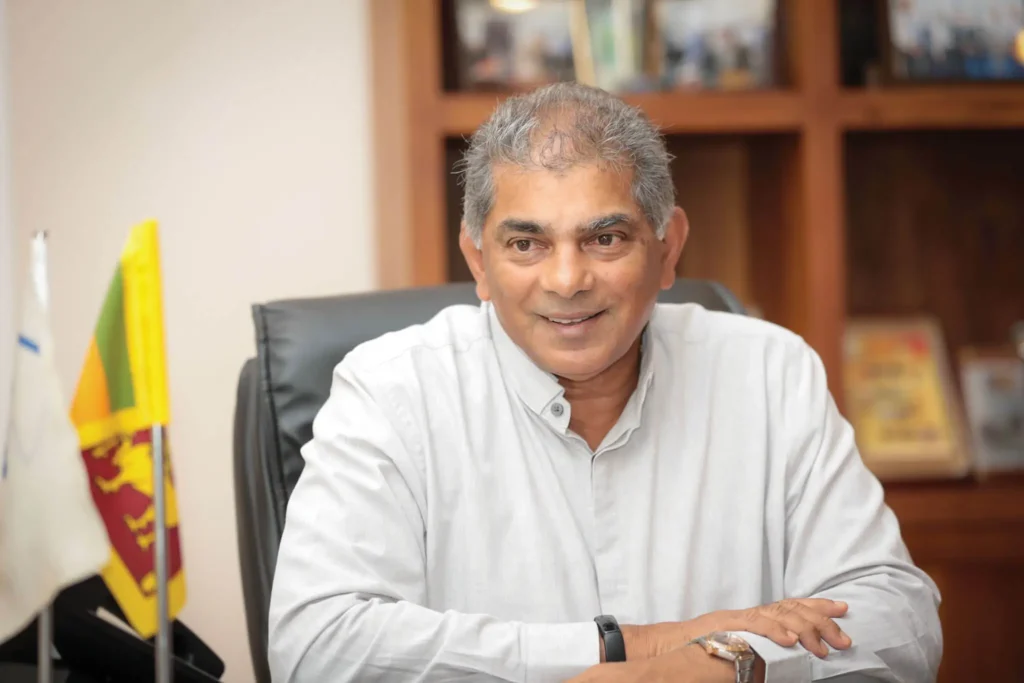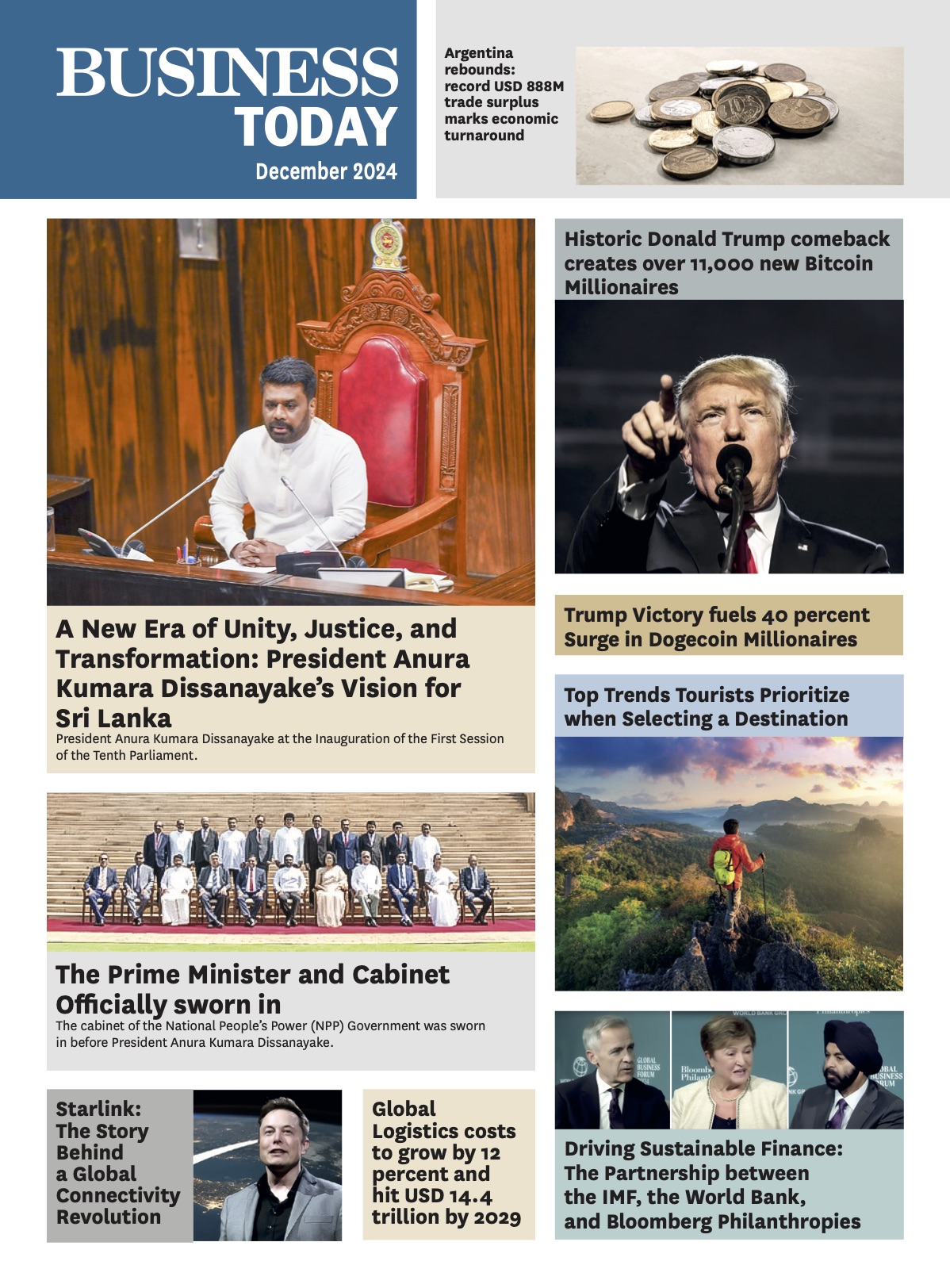
Speaking to Business Today, Rohan Fernando, Chairman, SLT Group, detailed the Group’s journey through 2021, opining on the commitment of clean management that drove a culture of change for the first time within the SLT Group resulting in savings, optimization of resources, and streamlining of skewed business operations. Importantly 2021 was a year that the management focused extensively on the well-being of the staff, making strategic decisions to achieve a balance between ensuring safety and service delivery. In an exciting year of activities and challenges, the SLT Group continued its forward march unabated, and in 2022 it journeys through domestic macroeconomic challenges and global upheaval. An unfazed Fernando continues his thrust to drive the domestic ICT landscape to exponential heights.
By Jennifer Paldano Goonewardane.
Photography Menaka Aravinda and Sujith Heenatigala.
The SLT Group has concluded a great financial year with 12.2 billion rupees recorded as PAT. Could you elaborate on SLT’s journey in 2022 in light of what you had said that this all-time best record was possible because SLT adhered to zero corruption, waste control, high efficiency, and inclusive management?
As I accepted my post as chairperson, I was ecstatic about taking charge of a fantastic company. The first thing I did at the helm was to study the past annual reports for nearly a week. The P&L accounts showed commendable results, but massive borrowings by the company had impacted the cash flow, while the company had capitalized the interest on some of those borrowings. The failure to record interest payments in the P&L accounts resulted in increased profits and tax payments. Concurrently, the company’s cash flow dried up, driving the company, in turn, to borrow further to meet the demands in the P&L where dividends and bonuses feature large. Although I realized that it was a problematic precedent to correct, I tried rectifying it greatly. I started with restructuring the 53 billion rupees debt. Meanwhile, while examining the balance sheet, I noticed that SLT had nearly 590 prime properties, which, although they were vested with the company, were not registered with the Land Registry, a process that we started. Today, we have registered approximately 60 to 70 percent of the properties. We intend to clear some properties of squatters. SLT owns 37 acres in Padukka, where we had started construction of a university. We embarked on fortifying our immobile assets to strengthen the balance sheet, as we can justify our borrowings only by enhancing the balance sheet. At the same time, that will allow us to manage the equity ratio and gradually improve the cash flows.
Following the measures we adopted, from 2020, SLT has had surplus money in the cash flow. We reduced our debt ratio by 10 billion rupees, in 2020 to 43 billion rupees. Subsequently, in 2021, the year under review, we reduced the debt ratio by a further three billion rupees. Our debt ratio currently is a little under 40 billion rupees. We achieved our remarkable profit after tax of 12.5 billion rupees after investing nearly 15 billion rupees in infrastructure development. We are gradually arriving at a comfortable debt-equity ratio and cash flow management. Our remarkable achievement in 2021 is a result of concerted efforts to clean our act from the top, ensuring that everyone down the line remains clean.
I am proud to say that the SLT Group can record zero corruption in the year under review because its new Board of Directors maintains a corruption-free regimen of the highest standard. One way in which we stopped corruption was by eliminating intermediaries. SLT had many intermediaries supplying products and services, which the management realized was unnecessary when we are the oldest telephone company in Sri Lanka with a 160-year-old history. Today, we deal with Silicon Valley companies such as Amazon, Sysco, NetCracker, and Minerva in places like Palo Alto and San Jose. Our ultimatum to those principles was to either work directly or we would look elsewhere. Our decision has ruffled many feathers, resulting in me enduring many threats. However, we are unwavering in our focus, and thanks to the Board’s direction, we have been able to bring discipline into the company by eliminating unwanted wastage.
Another move that led to zero corruption and the ending of wastage was the termination of all inter-competitor lawsuits through out-of-court settlements. To my mind, most of those lawsuits were dragging on with no solution in sight. In the beginning, one should know whether it is settleable or worthy of fighting in a court of law, especially if it is a criminal act. When the company settled the cases eventually, we found that the company was at a loss and sometimes bordering on questionable arrangements. I think SLT and Mobitel in 2020 and 2021 saved around 250 million rupees in annual legal charges. We have diligently adopted minimizing wastage and working through research and development to convert waste to cash, such as selling recovered copper from copper lines as we convert to fiber optic cables. We are trying to harvest the steel telephone poles along railways for recycling or through R&D to use them for bridges and elephant fencing. Rather than allowing such discarded material to decay, we are working with the Railways Department to draw up a plan for their usage.
We know the transformation that the mobile phone revolution has made in the lives of millions of people in the last decade.
Sri Lanka Telecom has been making significant expansions and upgrades to its 4G network while working with 2G and 3G architecture. Although 2G technology is limited to voice calls and text messages, we don’t intend to discontinue that architecture while migrating to 4G. Now that we have 3G technology that allows additional features such as mobile internet access, video calls, and mobile TV, we are preparing to migrate towards 4G by 2023. So, rolling out the 4G network is a significant infrastructure project for us, which we intend to do through optical fiber cables. That would lead to a decline in Multi-Service Access Nodes from 7,600 to about 800. There will be colossal savings and waste reduction from this migration. Regarding efficiency, SLT is one of the first companies to introduce staff incentive schemes in a long time. We have also initiated the work from home concept. Allowing employees to work from home negates the need to travel to Colombo from places as far as Matara and instead work from a designated place close to their area of residence. Deploying 14 buses to ply to various places during the pandemic, we realized the practicality of allowing employees to work from home.
SLT was one of the first organizations in the country to initiate the work from home concept during the pandemic on a large scale. SLT introduced a POD-based working model to allow our regional telecom officers to work collaboratively from multiple locations close to their area of residence. While continuing that practice, we are introducing apps to identify the time clocked and the quality of work to ensure that the new operating environment achieves the desired level of efficiency.
The most important achievement in 2021 was introducing inclusive management. When I joined SLT, I wasn’t sure whether inclusive management was possible in an organization riddled with industrial disputes and strikes. It was a daily battle balancing the trade union demands. Amid the rising cost of living, shortages of commodities, and essentials, some trade union actions were politically-driven. Of course, the country’s status, in general, drove the staff to demand more benefits.
By the end of 2020, we significantly reduced tension between trade unions, the staff, and the management by building confidence through regular dialogue. However, I feel that we could do more through the Human Resources Department by making it more people-friendly, which has been a vital discussion area at recent Board meetings. The Human Resources Department should treat staff members who come to them pleasingly rather than giving the vibes of a Police unit. They should not consider an employee’s complaint a threat. We must remember that employees will always complain, and it’s their right to complain. However, every employee deserves a hearing. We are trying to change the current human resources culture to strengthen inclusive management further. Today, SLT trade unions are confronting the problem of relevancy given the lull in their activities during the pandemic-driven lockdowns. We proposed that they drive our Environmental Social Governance projects and take the credit therein. The ESG replaces the old CSR projects, which I believe is just an eyewash of giving a one-time handout to a target group, after which all engagement ceases. In contrast, the ESG proposes long-term involvement where the organization ensures the sustainability of a project. We initiated our ESG project at the beginning of 2022 in Meeyagala in the Monaragala District as the National ‘Mee’ Tree Planting Program. Meeyagala is a very remote and underprivileged village. However, it is historically significant for giving refuge to people fleeing the wrath of the British colonizers during the Uva Wellassa Rebellion.
We launched the program at the Meeyagala Sri Meththarama Temple as the first phase. At the same time, Mee saplings were planted at the Meeyagala Primary School, while we distributed 500 plants among Meeyagala villagers. The Mee tree, known botanically as Madhuca Longifolia, is indigenous to Sri Lanka. In the ancient times of the kings, people used oil extracted from the Mee tree for cooking and illumination. The oil had medicinal properties too. As records show, it was a notable species in our cultural and historical lexicon. A tablet in Anuradhapura proclaims the edict of a king who banned the cutting of the Mee tree that was punishable by death. We selected the Mee tree for our environmental stewardship initiative for its significant benefits as a natural pest control promoter, contribution to producing organic fertilizer, aiding air cleansing, and as a source for herbal medicines. Before Mee trees became scarce, they were a common sight adjacent to the paddy fields allowing bat droppings from those that came to the tree for its fruit to enter the waterways to provide the soil with a rich source of phosphorous and nitrogen. The upshot of the bat exodus to the Mee tree was that they ate the insects harming the surrounding crops.
The sustainability aspect of the project involves tracking a tree’s growth through geotagging. Our project exposed us to a dire need in the Meeyagala Primary School, which had to make do with a tiny toilet. Hence, we invested in building new toilets for this co-education school. We donated books to the school’s library. We are continuing our involvement as the school will receive solar power and an IT laboratory. Compiling the progress of our first exercise is vital to gauge the degree of progress. We will have an extensive database of our activities, progress, results, and improvements by the end of the year. That process will help us develop a code of engagement as we advance.
The second National ‘Mee’ Tree Planting Program was launched in March 2022 at the Umandawa Global Buddhist Village with the participation of the Venerable Siri Samanthabhadra Arahath Thero. The third phase of this project will be with the Venerable Soma Thera in Ruwanweliseya, where we hope to plant thousands of Mee trees along the Anuradhapura Vavuniya Road. Using the Mee tree as the center of our program, we plan to introduce trees like jackfruit, which is also valuable for environmental sustainability and society. It’s a delight to see the active participation of trade unions and staff supporting our environmental sustainability governance program during the launches.
How has the SLTMobitel brand unification helped propel growth in the year under review? Could you tell us the significant areas contributing to Mobitel’s highest profits in its 28-year history?
Brand unification was the most challenging task as many had attempted it in the past and failed. As a result, the staff had lost confidence in the management. At my first meeting with trade union representatives, they inquired whether I planned to change the SLT brand, given my experience as a marketeer who had built brands in the past. They revealed that those before me who had initiated the brand unification had wasted colossal sums of money on the process leading to misappropriation. I took note of that.
We did the brand unification because it was essential. Mobitel had many verticals, with sparse connectivity between the brands and different agencies serving different purposes, resulting in colossal sums of money spent on such disconnected operations. Despite that, there was stagnation. It was no wonder that a number one company slid to the second position in 2013 as they failed to understand the customer’s mindset. The people within didn’t understand the power of SLT and the power of SLT in unison. They could not see the bigger picture of the strength that we could harness to augment our services to the people.
We initiated the brand unification by creating a competition among advertising agencies to develop the best coherent brand identity that is instantly recognizable to the consumer and portrays a harmonious relationship. We entrusted the selected agency with carrying out the public relations functions associated with the brand unification. The new logo is significant to our shift. By infusing the concept of Yin and Yang into the new logo, we are signifying complementarity and interconnectedness relatable to the customer. This unified platform helped us bring together all our services and products under a single banner. We created unusual euphoria around the combined strength and the stability of this alliance, thereby increasing customer confidence.
By amalgamating the SLT and Mobitel stores, we have made them into a one-stop provider for all telecommunication needs. Our next step is to locate all offices on land owned by SLT and to construct new buildings where there are none. While we consolidated costs through brand unification, the hard part was to achieve topline growth and bottom-line profit. Mobitel was one of the better beneficiaries of that process. It managed to piggyback on the strength of SLT and reduce costs by amalgamating shared services resulting in a record profit in 2021. Mobitel is constructing a modern, state-of-the-art, nine-storey building at a property belonging to SLT in Welikada. While Mobitel is financing the construction, it will benefit from occupying the premises rent-free from SLT. The new Mobitel head office will unify all the scattered operations under one roof and save nearly 50 million rupees in rent.
Despite the SLTMobitel amalgamation, we still maintain two brand identities. SLT is a more unionized corporation type of operation, whereas Mobitel is a modern corporate. Hopefully, we will infuse that culture someday into SLT, and with that, we will be invincible. Our successful brand unification drive results from astute, systematic, and collective decision-making based on cohesive action and dialogue.
In a challenging year when accessing digital services was at one of its highest, how did SLT manage to provide uninterrupted domestic and global voice and data services?
No sooner than we took office in January 2020, the pandemic broke out. By the end of March 2020, COVID-19 had started spreading in Sri Lanka, and we were under a strict lockdown. The stories were frightening. The world gave conflicting claims while our medical pundits made matters worse. Fear was rampant as there was insufficient knowledge of the virus. Amid the confusion, we turned to our Business Continuation Plan for guidance. However, SLT’s BCP did not have a clause dealing with a pandemic-induced situation, forcing us to include a new paragraph delineating the pandemic. My foremost concern was for my staff in case of an infection. We gradually converted the company’s holiday bungalows into emergency intermediatory quarantine centers where an individual who has been the first contact could isolate. The SLT bungalows in Poththude, Anuradhapura, and Matara converted for COVID isolation had nurses visiting to check on those quarantining. Later on, we engaged in the hospital quarantine system, obtaining facilities at the Koggala Beach Hotel for our staff. Activating the eChanneling service allowed our employees to channel doctors and deliver medicines on the company account. We reduced the head office staff from 2,400 to around 350 by getting them to come only when necessary. When employees requested a risk allowance, I assured them that the company would bear the risk, and accordingly, we even delivered food to employees’ when they couldn’t leave their residences. The management allocated a substantial budget through the Board to meet those pandemic-related expenses. I am glad that we didn’t have a single fatality. We made it compulsory for our staff to get the vaccine. We set up a vigilant committee, now disbanded, representing all the staff through the trade unions, which met every week outdoors to discuss problems and solutions. We had a fully vaccinated staff of 95 percent at the last count. We are coaxing the few who are yet to get jabbed to get it done sooner.
During the worst period of the pandemic and the lockdowns, I came to work every day as I had to be an example to the staff. Against the advice of my family, I led from the front. As an essential service provider, many vital entities are dependent on us for the continuity and smooth management of their operations. Imagine the chaos, disruptions, and loss to business if our systems failed even for five minutes. SLT had a massive task of managing its systems without a break, which we did well, making us ready to meet even the worst pandemic in the future.
In July 2020, SLT was the target of a ransomware attack, which was detected and mitigated through our vigilant early warning systems. Henceforth, we strengthened the Security Operations Center, and 2021 was a safe year. We are working further to improve our security systems. When we took over, our security systems were fragile, lacking in cybersecurity threat mitigation strategies, which we have reinforced since to manage cyber threats, espionage, and physical sabotage to installations. We are working with the state intelligence service and the Ministry of Defense to protect our most important sea, land, and air installations. We have a network spreading east to west and north to south, and I’m proud to say that we have a very committed and robust set of people who consider protecting our infrastructure a national duty. In recent times when there is a fuel shortage, we have to make sure our backup generators are in working order, along with charged batteries, which are excellently supported by those in charge.
Considering the current energy crisis, and with the long-term in mind, we focus on promoting the green energy concept through our ESG projects. Today, green energy is a golden principle in the world telco industry. The primary theme of the Mobile World Congress Barcelona 2022, which I attended from February 28th to March 3rd, was halving carbon emissions by 2030 and reaching net-zero emissions by 2050. Currently, we are looking at how best to power our installations using solar power. We may even consider using hydropower to mitigate our carbon footprint and reduce humungous electricity bills. We envisage saving at least one billion rupees from our annual electricity bill of three billion rupees by installing solar roofs, hydropower, and wind power. We are considering some areas of saving as the construction of the new Mobitel head office continues. The new head office will be fitted with solar roofs, rainwater harvesters, and low-energy lights. We are continuously researching how best to reduce our dependence on fossil fuels and adopt renewable energy sources, thereby reducing costs and enriching the environment.
I feel that the pandemic was a blessing in disguise. It helped us think differently, which we should have done under normal circumstances. But we didn’t even attempt to do them because life was easy and the status quo was comfortable. The upshot of the pandemic has shown that the head office operation is manageable with a small staff. Eventually, we will go for a pruned in-office staff, while the rest could work close to their area of residence. Despite one of the biggest challenges faced by the company, the management paid employees in total and managed to give their bonus.
The pandemic transformed the way students studied and interacted with their teachers. When the education landscape changed, telcos had to respond quickly and effectively. What can you tell us about the colossal role that SLT played in this regard?
The world is moving towards working through digital platforms. The most substantial companies in the world are tech companies. Hence, SLT is transforming itself from a telecom company to a tech company, a feat we are confident in achieving. We are in the epicenter of technology backed by its 160 years plus history, knowledge, and a massive cadre of 600 engineers. We are launching higher education in research-based learning to augment education in engineering, technology, computing, and IT, among other subjects. As the education landscape changed with the pandemic, we responded appropriately by assuring the government of providing digital-based education services through fiber connectivity. Fiber optical connectivity is the best and the fastest for children to learn through smartboards. Students can learn online through the PEOTV channel, activatable on their mobile phone through the OTT or the IP platform. Our mission is to reach the nearly 600,000 households in the country through PEOTV, which will lead to an unbelievable change in the education landscape.
I am a product of the 1970s education system that was more than books-based. Our teachers taught us to become men and women of the world. Education, sports, and extracurricular activities were never negotiable. Afternoon recreation was compulsory at the boarding school in St Thomas’ College Gurutalawa. Back then, we didn’t consider tuition a necessity. Our masters would coach the weak students after sports or during the weekend free of charge. Today children go to school but spend much money learning from tuition teachers. Unfortunately, there is enormous parental pressure on children to study and attend tuition, robbing them of their childhood. The Olympic dictum ‘Mens Sana in Corpore Sano,’ meaning a healthy mind in a healthy body, is truly sacrosanct. A healthy body results from extracurricular activities, sports, and exercise, which today’s children fail to experience.
So, SLTMobitel is helping children reclaim their childhood by allowing them to be involved in sports and, once home, brush up their school work through online lessons. Through our option, students can learn online what they learn from tuition. To my mind, that is the best social service SLT has done for this country. And that happened thanks to the pandemic. We have several channels providing education support, and soon we will have it available on-demand where the student can access the required content on request at a preferred time. We may give this service at a minimum price, cheaper than a tuition teacher’s fee. There is value to providing education even at a minimum cost. Sri Lanka should move from the practice of providing free primary, secondary and higher education to students, who then agitate for a job in the state sector from the government to earn a salary without working. For that nation, there’s no future, and that I believe has to change. Anything given free goes unappreciated, in my opinion. But we should have a safety net for the poorest of the poor who are deserving.
After completing the Advanced Level examination, I didn’t go to university as I felt it would be a waste of time in the 1970s as the JVP was ruling the universities, so we started working. I don’t think I have done poorly. My parents didn’t push me to go for tuition and pass exams, but we learned and are still learning. Learning is perpetual, unconditional, and available for anybody. And that is the service we are providing the children of Sri Lanka through SLT’s online learning platform.
What can you tell us about the progress of the eChanneling platform since SLT acquired it?
eChanneling as a pioneer ICT service provider to the healthcare industry has created a significant impact by easing the process of facilitating doctor appointments. We have rehashed the whole concept, including replacing the old logo and launching it as an e-channel platform by SLTMobitel. In a challenging year for healthcare services, eChanneling offered many services during the pandemic, such as audio and video consultations, prescription uploads for drug delivery, mobile lab service reservation, and drive-through PCR testing channeling. We posted one of the best-ever results for a small company following our acquisition. We are gearing for more acquisitions, partnerships, and product innovation to uplift Sri Lanka’s digital lifestyle experience.
In looking to create new revenue streams, we intend to introduce an app to store medical records with privacy options. This way, an individual in any part of Sri Lanka desiring to consult a doctor in Harley Street can do so online while providing access to their medical records to the doctor in London. As people’s online access to medicine and medical facilities will be revolutionary in the future, we are trying to develop those relevant apps through eChanneling. We provide a platform to the National Transport Medical Institute of the Ministry of Transport to facilitate online reservations for driving license medical tests, thereby allowing the public to access its services safely and securely. Likewise, SLTMobitel’s mobile money platform mCash has made great strides during the pandemic. It has become a popular mode of digital cash payment as we connected with financial institutions to provide more customers access to a safe and secure platform that negates the use of hard cash.
Going forward, 2022 is an exciting year for SLT as we gear to introduce several new products. Our vision for every house is to transform it into a smart home through fiber-optic broadband connectivity to create a Wi-Fi zone that enables it to become a place of work and entertainment and provide home security through CCTV cameras. As I see the future, the potential and the possibilities are endless.
As the country faces challenging macroeconomic conditions, how do you plan to provide uninterrupted services to cover multiple demographics while being consumer-minded in pricing and packaging?
Sri Lanka Telecom has always been consumer-minded in pricing. Many expect more concessions, which is not a viable option. We must be steadfast in infrastructure investment to remain on par with global telco and IT industry trends. Annually SLT invests nearly 20 billion rupees in infrastructure development without encumbering the government. SLT is on Board the largest SEA-ME-WE 6 fiber optic cable project linking Southeast Asia, the Middle East, and Western Europe at 12 locations from Singapore to France, which has commenced work in 2022. As one of the consortium partners, SLT injects 50 million dollars in investment into the project, not a burden on the exchequer. By joining the consortium, SLT will be able to scale up its high-speed network capacity to serve Sri Lanka’s fast-growing digital ecosystem. Today a population of 22 million people has 40 million mobile connections, which means people can afford digital connectivity. If people can afford mobile phones, they can spend a small amount of money to make them operational. Our basic package with connectivity starts at 600 rupees a month, which is very reasonable given that today an individual needs that amount of money daily to buy all three meals. SLT must be the cheapest in terms of providing telecommunication connectivity probably in the world. However, sustaining this pricing in the long-term remains doubtful as we are under severe stress owing to the country’s forex issue.
The management’s role is to ensure the wellbeing of 10,000 people and their families while safeguarding infrastructure and investing in infrastructure development, security, and continuity, which are all challenges. Despite the challenges, the company is determined and committed to keeping its customers happy. We are confident that we can achieve all our objectives in 2022 and onwards.
As you stated, the impact of the current forex challenges was relatively low on your company due to prudent forex management. Against this backdrop, how do you plan to navigate plans of expansion/development?
Right now, we have a problem with the forex crunch. Although we are managing our affairs in this current scenario, we are not in a position to mitigate it as of now. The challenge for SLT is the enormous amount of forex spent on importing equipment and in payment to foreign companies providing us with IP solutions for our digital platforms. On our part, we have taken action to manufacture some of those imported devices and equipment locally. For instance, we have started a joint venture with a ZTE phone company to manufacture an affordable 4G telephone in Sri Lanka to help save forex.
We are discussing with several companies to initiate joint ventures to manufacture devices from locally available raw materials such as silica and graphite, which are vital for the telco and the IT industry. As the government plans to establish five technological parks to drive a techno-entrepreneurship-driven economy, we hope it will attract big companies like Microsoft and Amazon to Sri Lanka, which will augment the country’s forex reserves.
As we look to the future, the forex issue is challenging to SLT. However, as an organization, we manage our forex reserves from various sources of foreign income, such as from our partnership in a joint venture with Singapore’s Indian Ocean Cableship Private Limited to manage the submarine cable depot in Galle. The Mobitel roaming service also generates an income in forex. Our foreign revenues are helping with external payments in dollars, which is challenging as we expend much money in the process. But I’m optimistic that we shall manage. In the medium to long-term, we will move to manufacture in Sri Lanka to reduce our dependency on imports. Amid the current economic challenges, the Sri Lanka Telco Service Providers Association that I initiated will help all telcos band together to present our issues and concerns as a united fraternity of industry players.
Online and e-commerce platforms became a means through which small and medium businesses navigated their activities through the pandemic. How do you think their future course would be in this space, given the challenging marketplace they are operating in right now?
Since the end of the war, many entrepreneurs have emerged in the north and the east. During the pandemic, as I traveled to the north, east, and the rest of the country, visiting our installations and offices, we found much entrepreneurship at a micro-level. Given SLT’s vast network reaching every part of the country, accompanied by the best people-connecting platforms, our ‘Power to Your Dreams’ initiative empowers micro-businesses by providing commercial connectivity backed by cutting-edge technology to cater to the different needs of businesses. Our platforms empower micro-business owners in every area to connect to their supply chains and the global marketplace. Besides, most entrepreneurs can work from home through affordable home broadband connectivity, negating the need to occupy high-rent paying offices. Our facility lets them operate from a room of their home converted to an office, the most cost-effective way of running a business these days. SLT is committed to this process, and right now, we are supporting their businesses through our robust and efficient service.
SLT has been the only company with State-owned equity free of issues for two decades. And despite the current forex issues, you are making a profit. What is the advice you would give other institutions in this regard?
SLT is a success story of privatizing a once lethargic and burdened state-owned enterprise. The SLT Group is a public quoted company with a State-owned equity investment of 49.4 percent. Annually, the government accrues 20 to 30 billion rupees in taxes and two to three billion rupees in dividend income from SLT. Sri Lanka Telecom is the model the government should follow in dealing with other state-owned enterprises. All state-owned enterprises have many non-mortgaged free-hold assets. They can be rid of their debt to the exchequer by monetizing those assets. The Postal Department, for instance, I believe should be the FedEx or UPS of Sri Lanka. Years ago, the Postal and Telecommunications Department was separated, and the Japanese introduced valuable systems into the privatized telecom sector. Today, SLT operates along the lines of a commercial, corporate entity, sans issues while exemplarily taking care of its staff. Of course, we have too many employees, a legacy that SLT is still carrying. We hope to resolve this by creating foreign job opportunities through SLT Global, deploying local staff to overseas positions. All loss-making government entities should receive an ultimatum to be privatized, or else, the Treasury should withhold further funding.
I believe we can turn loss-making state-owned enterprises around. Today’s reality is that most state-owned enterprises are begging from the government. The Ceylon Electricity Board, the Petroleum Corporation, and the Railways Department have enormous assets that they cannot fully utilize. Unlike any other government entity, the Railways Department has vast assets. There are many ingenious ways the Department can use those assets to bring in more revenue. For instance, the Department can collaborate with the Tourist Board to promote tourism. Despite the State’s massive investment in the railway line infrastructure, how often does a train travel? Only a public-private partnership will lead to a fruitful outcome from such loss-making state-owned enterprises.
The road and rail networks in the country are one of the best globally. I’ve heard that our road network and the Ceylon Transport Board are better than Greyhound Lines and other transport systems in any part of the world. Our public transport system reaches even the remotest village. Our postal system goes to every address, however remote. The Postal Department is easily convertible into a cash cow. Likewise, by eliminating internal mafias, the government can transform the Ceylon Electricity Board and the Railways Department into cash cows. Moreover, when the wrong person is appointed to head these institutions, they are caught misappropriating, leading to a tussle between the management and the staff, which spills over to trade union action. So, the main focus of the business is lost as trade union action ensues, leading to a drop in business. Eventually, the public loses confidence in the system.
I believe institutions will be run efficiently by business people who have managed prior businesses, and they need to operate in an environment free of political interference. I had political interference at the outset, which the President himself intervened to remove. I didn’t come to this position armed with IT or engineering knowledge. Many media articles questioned my credentials and wondered what a man from the tea trade would do at SLT. You don’t need rocket scientists to run this operation, but you need focused people who can manage the business.
How have the Group’s services helped to reduce the digital divide?
Our island-wide network has provided one of the best coverages one could expect. Sri Lanka has mobile coverage of about 95 percent, which not very many countries can claim. In the US, there’s no connectivity in the interior. Of course, those countries are enormous, so the process is costly. But Sri Lanka has connectivity even in the middle of a desert, and that’s the level of infrastructure development we have done through SLTMobitel. We are continuing to improve our service connectivity.
While SLT has been leading from the front to reduce the digital divide in the country, I think the telco sector, in general, has contributed to reducing the digital divide in Sri Lanka.








